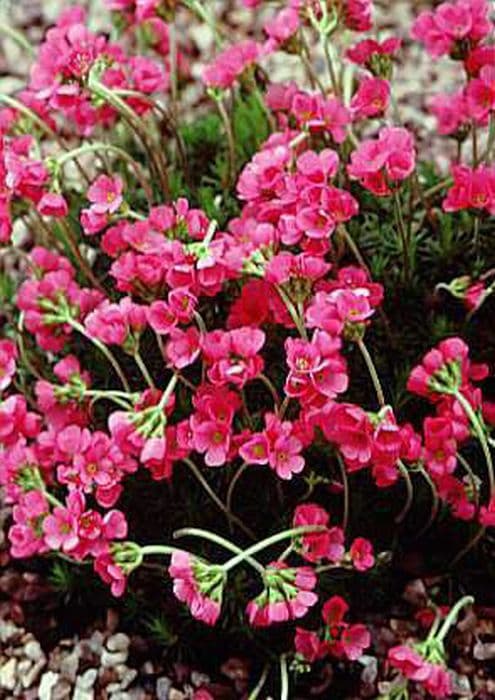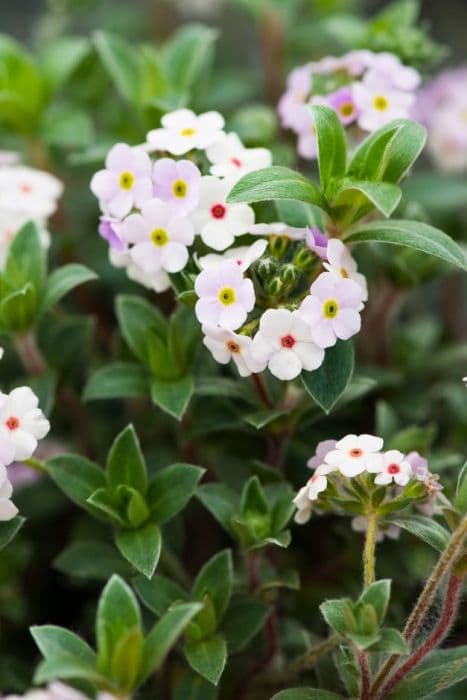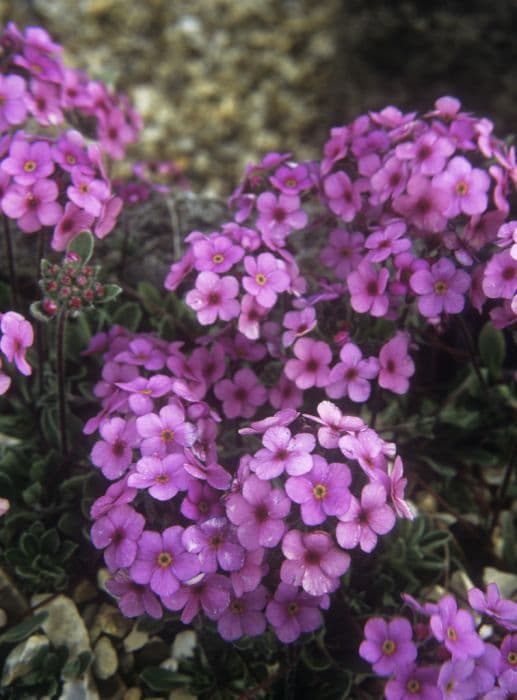Bear's ear auricula Primula auricula 'Blue Velvet' (Au/b)

ABOUT
Primula auricula 'Blue Velvet', also known as Bear's ear, showcases a distinct and eye-catching appearance. This perennial blooms with deep blue to purplish velvety flowers that carry a round shape with a slightly frilly edge, giving them a softly textured look. The center of each blossom is often highlighted by a bright, contrasting yellow to white eye, which adds to the charm and visual appeal of the flower. The petals can sometimes exhibit a gentle dusting of farina, a powdery coating that gives them a delicate, frosted appearance. The foliage of the Bear's ear is equally attractive, forming compact rosettes of fleshy leaves. These leaves are rounded, somewhat akin to the shape of an actual bear's ear, with a smooth to slightly textured surface. Their color is usually a rich, deep green, which provides a lush backdrop for the striking blue flowers. The contrast between the luxurious blue blossoms and the dark green leaves creates a dramatic display in the garden. All in all, Primula auricula 'Blue Velvet' is a captivating plant with its luxurious blue flowers and lush green foliage, making it a prized specimen for plant enthusiasts and gardeners looking to add a splash of rich color to their plant collection or garden beds.
About this plant
 Names
NamesFamily
Primulaceae
Synonyms
Bear's-Ear, Mountain Cowslip, Auricula
Common names
Primula auricula 'Blue Velvet'
 Toxicity
ToxicityTo humans
Bear's ear, like other Primula species, contains compounds such as saponins and primin that can cause mild to moderate toxicity if ingested. Consuming parts of the plant may lead to symptoms such as nausea, vomiting, diarrhea, and abdominal pain. In some individuals, particularly those with sensitive skin, handling the plant may result in skin irritation or dermatitis.
To pets
Bear's ear possesses compounds that can also be toxic to pets if ingested. Symptoms of poisoning in pets may include vomiting, diarrhea, and excessive salivation. In more severe cases, ingestion may lead to signs of gastrointestinal distress or anorexia. It is important to keep pets away from the plant to avoid any potential health issues.
 Characteristics
CharacteristicsLife cycle
Perennials
Foliage type
Evergreen
Color of leaves
Green
Flower color
Blue
Height
6 inches (15 cm)
Spread
8 inches (20 cm)
Plant type
Herb
Hardiness zones
4
Native area
Europe
Benefits
 General Benefits
General Benefits- Ornamental Value: Provides vibrant blue-purple flowers which add color and visual interest to gardens and containers.
- Compact Size: Suitable for small spaces, rockeries, and alpine gardens due to its modest size.
- Low Maintenance: Requires minimal care once established, making it a good choice for gardeners of all levels.
- Cold Hardy: Can survive in colder climates, making it a versatile plant for various garden zones.
- Attracts Pollinators: Flowers attract bees and butterflies, supporting local ecosystems.
- Long Blooming Period: Offers a prolonged display of flowers, typically from mid-spring to early summer.
 Medical Properties
Medical PropertiesThis plant is not used for medical purposes.
 Air-purifying Qualities
Air-purifying QualitiesThis plant is not specifically known for air purifying qualities.
 Other Uses
Other Uses- The auricula flowers can be pressed to create intricate natural art pieces, capturing their unique patterns and colors.
- Garden enthusiasts can hybridize Blue Velvet with other Auriculas to create new varieties with unique color patterns.
- Auricula Blue Velvet petals are sometimes candied as edible decorations for desserts, providing a mild flavor and vibrant color.
- These plants can be used in miniature gardens or fairy gardens because of their compact size and striking colors.
- The vibrant flowers can serve as a natural dye for fabrics, although the method is not commonly used.
- The leaves of Auricula Blue Velvet can be used as bookmarks, with their interesting texture adding a natural feel to your reading experience.
- It is integrated into educational programs for children to teach plant life cycles and flower anatomy due to its distinct features.
- The plant can be used in aromatherapy gardens, where its subtle natural scent could be appreciated for relaxation.
- Auricula Blue Velvet can be grown in terrariums, provided they have the proper cool and moist environment they prefer.
- Their blooms can be used in artful table setting designs, such as making ice cubes with flowers inside for elegant drinks.
Interesting Facts
 Feng Shui
Feng ShuiThe Auricula is not used in Feng Shui practice.
 Zodiac Sign Compitability
Zodiac Sign CompitabilityThe Auricula is not used in astrology practice.
 Plant Symbolism
Plant Symbolism- Uniqueness: The 'Blue Velvet' auricula's distinctive blue petals offer a sense of rarity and exceptionality, symbolizing the uniqueness of an individual or situation.
- Boldness: The intense blue hue and the velvet-like texture of the petals represent confidence and the courage to stand out.
- Beauty: Auriculas are often renowned for their ornamental value, with 'Blue Velvet' no less, symbolizing aesthetic appeal and the joy found in beautiful things.
- Mystery: The rich blue colour can symbolize the unknown or the mystical, alluding to intrigue and enigma.
- Emotional Depth: Blue, often associated with depth and stability, can represent deep emotion or sincerity.
 Water
WaterFor the Bear's ear, known as Primula auricula 'Blue Velvet,' it's crucial to maintain moist soil without it being waterlogged. During the growing season, typically spring and summer, water the plant once every week with about 16 ounces of water, depending on the pot size and the ambient temperature. Reduce the frequency to every other week during the dormant period in fall and winter, ensuring the top inch of soil dries out between waterings. Always use lukewarm water and water directly onto the soil to avoid wetting the foliage, which can lead to fungal diseases.
 Light
LightBear's ear thrives in bright, indirect sunlight. The ideal spot is one where it can receive morning light but is shielded from the intense direct sun of the afternoon. East-facing windows are often ideal for these plants. Ensure the plant is kept in a well-lit room, as insufficient light can result in weak growth and fewer flowers.
 Temperature
TemperatureBear's ear prefers a cool to moderate temperature range. The ideal temperature for this plant is between 50 and 60 degrees Fahrenheit. It can survive minimum temperatures down to about 40 degrees Fahrenheit and can tolerate maximum temperatures up to 75 degrees Fahrenheit. Protecting the plant from sudden temperature changes and drafts is important for its well-being.
 Pruning
PruningPruning Bear's ear mostly involves deadheading spent flowers to encourage new blooms and removing any dead or yellowing leaves to maintain its appearance and health. Pruning can be done as needed throughout the growing season, usually in the spring and summer. The best time to do heavy pruning is in the early spring before new growth starts, which can also help to rejuvenate an older plant.
 Cleaning
CleaningAs needed
 Soil
SoilAuricula Primrose (Primula auricula 'Blue Velvet') thrives best in well-draining, slightly alkaline soil with a pH between 6.5 and 7.5. A soil mix containing one part loam, one part peat-free compost, and one part perlite or grit to aid drainage is ideal for this plant.
 Repotting
RepottingAuricula Primrose should be repotted annually to replenish nutrients in the soil and prevent overcrowding of the roots. This is best done in late summer or early fall, after blooming has finished.
 Humidity & Misting
Humidity & MistingThe Auricula Primrose prefers moderate humidity levels. It thrives best with humidity around 50-60%. Avoid excessive humidity to prevent issues with mold and rot.
 Suitable locations
Suitable locationsIndoor
Auricula Primrose needs bright, indirect light and cool temperatures.
Outdoor
Plant in partial shade and shelter from strong winds.
Hardiness zone
4-8 USDA
 Life cycle
Life cycleThe Primula auricula 'Blue Velvet', commonly known as Auricula or Mountain Cowslip, begins its life cycle when its seeds germinate in a moist, well-drained growing medium. Emergence of the seedlings marks the start, which then develop true leaves and establish themselves as young plants. The vegetative stage involves the growth of foliage and development of a strong root system. This perennial enters a blooming phase in spring, producing distinctive blue flowers that attract pollinators and subsequently set seed after fertilization. Once flowering ends, the plant enters a period of dormancy in colder climates or may continue to grow vegetatively in milder conditions. With proper care and conditions, the Auricula's life cycle can repeat for several years as it returns from dormancy to bloom each spring.
 Propogation
PropogationPropogation time
Spring-Early Summer
Propogation: The Primula auricula 'Blue Velvet', commonly known as Auricula, is typically propagated by division, which is best done in the late summer or early fall, after flowering has finished. To propagate by division, carefully lift the plant from the ground and gently separate the clumps into smaller sections, ensuring each section has a piece of the root system attached. These new divisions can then be replanted in well-draining soil, spaced approximately 6 inches (about 15 centimeters) apart, and watered thoroughly to establish them. This method of division helps to rejuvenate older plants and also to produce new plants that are genetically identical to the parent, maintaining any unique characteristics of 'Blue Velvet', such as its striking blue flowers.









